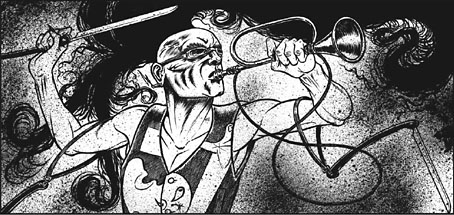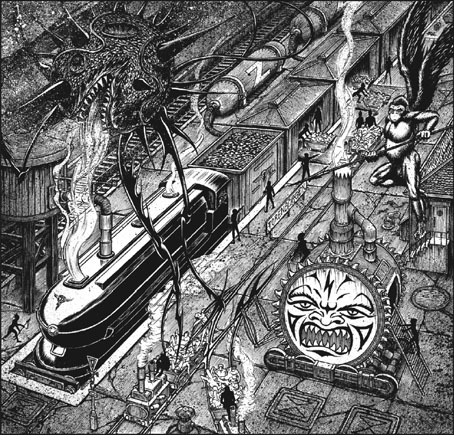
At long last, the news that many people have been waiting for: the Reverbstorm book is now on sale at Savoy. From the hyperbolic press release:
“Surfin’ bird Bbbbbbbbbbrbrbrbrbrb…awawawawawawawaaaaaah! A-pa-pa-pa-pa-pa-pa-pa-pa-pa-pa-pa-pa-pa-pa-pa-pa-pa-pa-pa-pa-pa-pa-pa-pa-pa-pa-pa-pa-pa-pa-ooma-mow-mow Papa-oom-mow-mow!” The Trashmen, Surfin’ Bird
Welcome to the nightmare metropolis of Torenbürgen, where New York’s Art Deco architecture has fused with the termination machinery of Auschwitz. In this urban inferno Jessie Matthews is singing Sondheim, James Joyce is at work on a new novel and Lord Horror, ex-Nazi propaganda broadcaster and Torenbürgen’s model citizen, is stalking the streets in search of fresh victims for his razors. Murderous apes infest the alleyways, Ononoes feast on the living and the dead, while above the rooftops the Soul of the Virgin Mary drifts like a swollen Lovecraftian dirigible, picking at bodies destined for the charnel furnaces.
Lord Horror: Reverbstorm is a unique graphic collaboration between writer David Britton, the author of four Lord Horror novels, and artist John Coulthart, whose book of Lovecraft-derived comic strips and illustrations, The Haunter of the Dark, featured a collaboration with Alan Moore. Reverbstorm was originally published in serial form and is now being presented in a single volume for the very first time. Britton’s debut novel, Lord Horror (1990), was the last work of fiction to be banned in the UK; an earlier Lord Horror comic series, Hard Core Horror, was also banned by a British court in 1995. Coulthart’s death-camp artwork from the final issue in that series appears in Reverbstorm as a prelude to the main narrative.
There’s never been a comic like this surreal collision between Modernist art and pulp aesthetics, a world where Finnegans Wake is drenched in Alligator Wine and Picasso’s Guernica is invaded by Tarzan’s simian hordes. Ambitious, transgressive and meticulously rendered, Reverbstorm is one answer to the eternal question posed by those cultural philosophers, The Cramps: “How far can too far go?”
“Bababadalgharaghtakamminarronnkonnbronntonnerronn-
tuonnthunntrovarrhounawnskawntoohoohoordenenthurnuk!”
James Joyce, Finnegans Wake

Previously on { feuilleton }
• Reverbstorm in print
• Reverbstorm update
• James Joyce in Reverbstorm
• A Reverbstorm jukebox
• Reverbstorm: Bauhaus Horror
• Reverbstorm: an introduction and preview


Wow, I am all envy and full of admiration! While admittedly my taste for violent imagery has lessened over the years, I can’t deny the power of the drawing and the way all the elements are beautifully integrated. I love to see work in black and white, and this is perfectly justified by the story. This must have been an intense experience, it is rare to see two minds working so elegantly on the same level – right up there with the best work of Alan Moore and Jack Kirby to name just two lower lights – welcome to the Starry Kingdom!
Thanks, John, that’s high praise. Now that review copies are going out I’m looking forward to the reaction, good or bad. Since the series has been incomplete for years it’s been impossible for anyone to fully say what they make of it.
I’m horrified there’s only one non-JC comment here. Hopefully Savoy’s selling more than just the one I bought.
One thing I noticed more in the complete volume than in the separate issues is that the escalation of violence and whatnot (for lack of a better word) is more gradual than I first realised, to the point where the abstract inner monologue weirdness of the eighth section was the only place left to go.
Congratulations John. Only having waited three years from buying issues 1-7, I can’t begin to imagine what it was like for you.
Thanks, Mitch. I’ve been told the sales are going well by Savoy standards which doesn’t surprise me since a lot of people had been waiting for this.
The escalating narrative progression was deliberate, as was the idea of the final section being a break from the rest, the only question being what form that would take when we got there. At one point it seemed it might be enough to do it all as computer stuff (this was in the mid-90s when computer art was more of a novelty) but I’m pleased with the combination of painting and digital work. Vector graphics have a quality that’s closer to ink drawing than Photoshop imagery so the disjunction isn’t so pronounced. Photoshop graphics, especially when they’re blurred, filtered, semi-transparent, etc, often look like nothing but themselves.
My general feeling has been one of relief that we got everything finished and got a great book at the end of it. I was worried for years that I might get knocked down by the proverbial bus and have this left as one of those terrible unfinished projects. Keith Seward interviewed me about the book recently so I’ll be posting those questions and my answers here in a week or so.